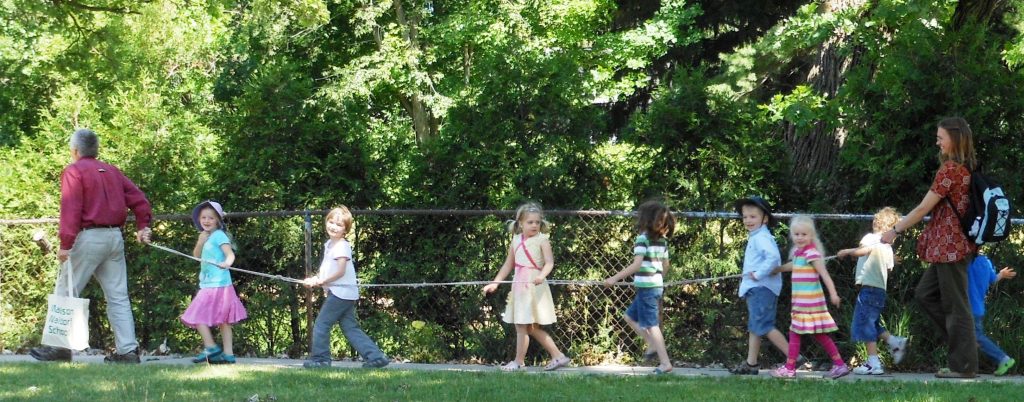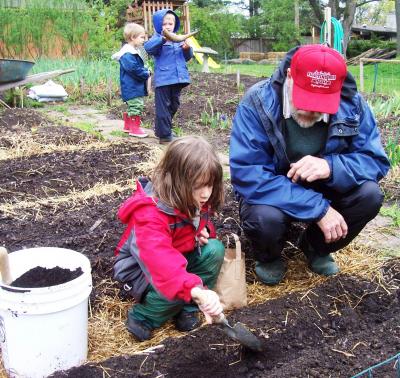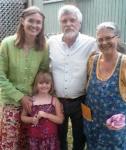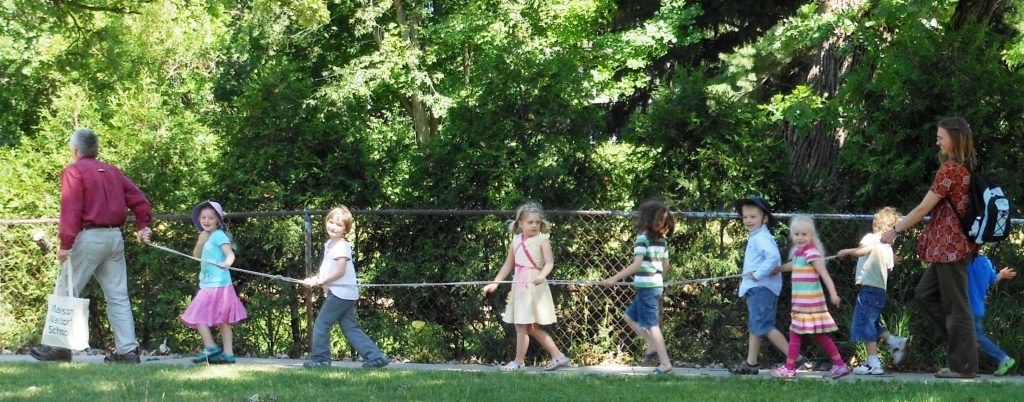
Here at The Orchard, our in-home, LifeWays-inspired child care place, being outdoors, rain or shine, hot or cold, is a given. It is also a challenge because, although we value and promote unstructured free play outdoors, we look for opportunities to share nature together. Apart from unstructured, surprise encounters with nature, this happens in two ways.
One day each week, beginning about 10:45, we gather the first aid kit, emergency phone numbers, cell phone, and our snack (muffins and milk—easily transported), position the children (eight, mixed age, three to five years, weather proofed) along the knotted rope and walk or meander, depending, a quarter mile to a five-acre woods, a city (Madison, WI) nature-park, adjacent to a public school. The principal cleared us to use the area. To the children, it’s “the forest;” like most forests it’s enchanted enough to be quite a draw. There are mixed, mature hardwoods and trails that take us into patches of wildflowers: trillium, Jack-in-the- pulpit, ginger, Virginia water leaf, May apple among others. One of the children, the first day out, gathered a bouquet of trillium before we could say “Jack-in-the-pulpit” so we had occasion to establish the understanding that all growing things, colorful or green, alas, were to remain unpicked, but they could gather sticks from the ground—to be left behind before our walk back. We have about an hour and fifteen minutes in the forest and apart from a snack break the children play and play, sometimes running wildly, sometimes hunkering down in one large group or in smaller groups as they camp. They bring us occasional treasures—a hickory nut, worm, beetle, shard of glass, bottle cap. Sometimes we pack out trash. They would play two, perhaps three hours had we the time. We are fortunate to have the forest, though as in most urban areas, there are a few other open green spaces nearby that we could use. And the effect might not be so different, mature hardwood trees and wild flowers notwithstanding, as the children just want to be active, with the option of settling in for a while, somewhere, to punctuate running with stillness. Helle Heckmann, at her center, Nokken, in Copenhagen, Denmark, makes extensive use of a cemetery, the terminus of their morning walk, for play. We talk of adding another day for a walk to the forest next school year, even though The Orchard has over and acre and plenty of trees. Leaving the house and heading out for an adventure in nature trumps most other activities. We teachers, by the way, share their enthusiasm.
 There is another occasion, though, when we explore nature possibilities at The Orchard. True, the children can gather sticks, turn over rocks and logs to see what’s underneath; we even build small campfires on cold days. But we also work with the children in the garden. This spring we planted seeds for spinach, kale, and carrots and seed potatoes, among a half dozen or so other vegetables. The children are harvesting the spinach now and we serve it, raw, as part of our lunch. Seed potatoes are very easy to plant and this year, like last, it will be a treasure hunt as we turn over the straw and soil and discover rows of potatoes which we will roast for lunch. There is bounty here; some we eat at The Orchard, some we share with the families. We’ve made grape jelly, apple sauce, rhubarb jam, even maple syrup when we tapped a few of our silver and Norway maples and boiled down the sap. We included a head of garlic and a small jar of maple syrup in the Easter baskets the children carried home. The silver maples may not yield the choicest syrup, like sugar maples do, but they are excellent alternatives, and they are ubiquitous in the Midwest and beyond. If you don’t have maple trees (and one tree a foot or so in diameter yields plenty of sap), neighbors might loan you theirs. The processes for making jams, jellies, maple syrup, etc. are not arcane mysteries and are of hands-on interest to the children. The teachers learn along the way, too, as our first maple sugaring last year attests. A vegetable garden needn’t take much space, is inexpensive, and introduces planting and harvesting savvy. The Orchard kids know where spinach, potatoes, pumpkins, etc. come from and have the satisfaction that comes of participating in the process. Of course, some children are ready to leave the garden after one minute, others after five or, rarely, ten so we plan carefully to get the most from those few minutes. The planting beds are already formed and tools and seeds/seedlings at hand. Depending on the activity, we take one or more children at a time into the garden so we can work closely with each, planting or harvesting. The Orchard has a break for the summer, but come their return in the fall the children will make an easier transition back as they harvest what they planted last spring. As for the chickens…but that’s another story, for another time.
There is another occasion, though, when we explore nature possibilities at The Orchard. True, the children can gather sticks, turn over rocks and logs to see what’s underneath; we even build small campfires on cold days. But we also work with the children in the garden. This spring we planted seeds for spinach, kale, and carrots and seed potatoes, among a half dozen or so other vegetables. The children are harvesting the spinach now and we serve it, raw, as part of our lunch. Seed potatoes are very easy to plant and this year, like last, it will be a treasure hunt as we turn over the straw and soil and discover rows of potatoes which we will roast for lunch. There is bounty here; some we eat at The Orchard, some we share with the families. We’ve made grape jelly, apple sauce, rhubarb jam, even maple syrup when we tapped a few of our silver and Norway maples and boiled down the sap. We included a head of garlic and a small jar of maple syrup in the Easter baskets the children carried home. The silver maples may not yield the choicest syrup, like sugar maples do, but they are excellent alternatives, and they are ubiquitous in the Midwest and beyond. If you don’t have maple trees (and one tree a foot or so in diameter yields plenty of sap), neighbors might loan you theirs. The processes for making jams, jellies, maple syrup, etc. are not arcane mysteries and are of hands-on interest to the children. The teachers learn along the way, too, as our first maple sugaring last year attests. A vegetable garden needn’t take much space, is inexpensive, and introduces planting and harvesting savvy. The Orchard kids know where spinach, potatoes, pumpkins, etc. come from and have the satisfaction that comes of participating in the process. Of course, some children are ready to leave the garden after one minute, others after five or, rarely, ten so we plan carefully to get the most from those few minutes. The planting beds are already formed and tools and seeds/seedlings at hand. Depending on the activity, we take one or more children at a time into the garden so we can work closely with each, planting or harvesting. The Orchard has a break for the summer, but come their return in the fall the children will make an easier transition back as they harvest what they planted last spring. As for the chickens…but that’s another story, for another time.

Submitted by: Les Beecher, Aleksandra Martinka, and Jacqueline Beecher for The Orchard.
The Orchard was born out of the impulse to provide care for young children, and respite for their parents, in a setting that optimizes outdoor work and play. Jacqueline Beecher, formerly a Waldorf class teacher, and Les Beecher, a retired English professor, founded The Orchard in 2007. Aleksandra Martinka organizes and directs the work and play for eight children and their families with our help.
